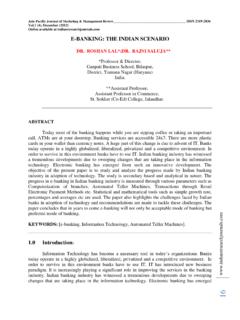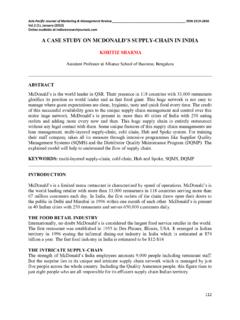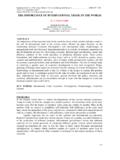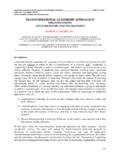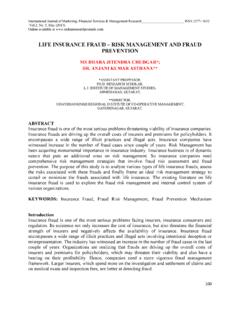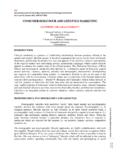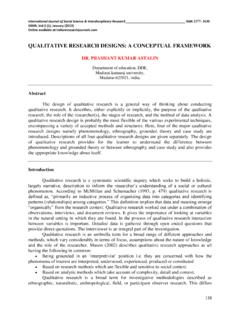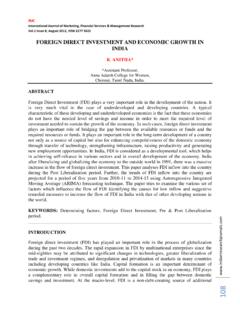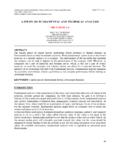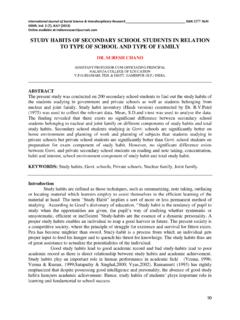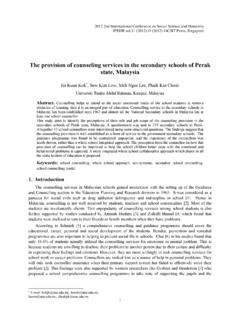Transcription of CHALLENGES AND EFFECTIVENESS OF INDUSTRIAL …
1 International Journal of Marketing, Financial Services & Management Research_____ ISSN 2277- 3622. , No. 6, June (2013). Online available at CHALLENGES AND EFFECTIVENESS OF INDUSTRIAL RELATION. ENVIRONMENT IN INDIAN INDUSTRIES: A STUDY ON ROURKELA. STEEL PLANT, ROURKELA, ODISHA, INDIA. NIBEDITA NANDA*; PROF. JAYA KRUSHNA PANDA**. *ASST. PROF. DAMITS, ROURKELA-42, ODISHA, INDIA. **PROF. & OF BUSINESS ADMINISTRATION, UTKAL UNIVERSITY, BHUBANESWAR. ODISHA, INDIA. _____. ABSTRACT. In today s dynamic business environment, every organization wants to be a successful organization. It cannot be possible without Human Resource (HR). The most important asset Human Resource (man power) is known as life blood of any organization. The success of any organization depends upon the performance of their Human Resource.
2 If question arises to find out the most important difference between ordinary organization and successful organization, the answer would be their HR. The organization also wants quality people. The greatest challenge before every organization is to recruit right people in right place. HR is the factors. Employee and Employer both are important. They are the two sides of the same coin. One cannot operate without the services of the other. The main purpose of this study is to observe the INDUSTRIAL relation operation and satisfaction level of the employees, to observe the different welfare schemes provided by the industry. KEYWORDS: CHALLENGES of INDUSTRIAL Relations, EFFECTIVENESS of INDUSTRIAL Relations, INDUSTRIAL Relations Environment _____. Introduction INDUSTRIAL Relations is a dynamic socio-economic a designation of a whole field of relationship that exists because of the necessary collaboration of men and women in the employment process of industry.
3 It is not the cause but an effect of social, political and economic forces. In order to understand the issues and problems associated with INDUSTRIAL relations, it is desirable to study its various evolutionary phases. Practically speaking, the growth of INDUSTRIAL relations in India is in no way different from that of other parts of the globe. The various stages of INDUSTRIAL relations progressed from primitive stage to factory or INDUSTRIAL capitalism stage. The emergence of tripartite consultative system and voluntary and statutory approach to INDUSTRIAL relations, immensely contributed to the growth of a particular system of INDUSTRIAL relations in our country. Also the fast changing technological development, INDUSTRIAL production techniques, 163. International Journal of Marketing, Financial Services & Management Research_____ ISSN 2277- 3622.
4 , No. 6, June (2013). Online available at and ideological values have brought forth in the INDUSTRIAL world a unique type of employer- employee relationship. For a proper theoretical perspective of INDUSTRIAL relations, it seems essential to have a historical review of INDUSTRIAL relations in India. Economists have traditionally identified four factors of production, viz., land labor, capital and organization. The role of labor as a factor of production is becoming increasingly important in the modern society. Capital and natural resource endowments, no doubt, are vital elements in the production process but it is labor which contributes most to the wealth of a company. Human beings are the active agents who accumulate capital, exploit natural resources, build social, economic and political organizations and carry forward national development.
5 Growing industrialization and the rapid expansion of the services sector resulted in the galloping demand for skilled labor after 50s. The emergence of the concept of human relations, human resource management (HRM) and human resource development (HRD) contributed to the growing importance of labor. The issue of INDUSTRIAL Relations arose from the issue of divorce of the workers from the ownership and management of the production process. This has brought about a sense of deprivation and loss of independence on the part of workers and is probably the primary cause of INDUSTRIAL disputes. INDUSTRIAL work has drastically reduced the independence of workers and made them mere cogs in the machine a kind of second class citizens . The disciplinary rules for work have become quite harsh and arbitrary.
6 The heterogeneous nature of workers, illiteracy and politicization of trade unions made it impossible for the workers to bargain for their rights united. All these factors have led to growing unrest among the rank of workers. The term INDUSTRIAL Relations refers to relationship between Management and Labor or among Employees and their Organizations that characterize or grow out of employment. Theoretically speaking, there are two parties in the employment relationship labor and management. Both parties need to work in a spirit of cooperation, adjustment and accommodation. In their own mutual interest certain rules for co-existence are formed and adhered to. Over the years, the State has also come to play a major role in INDUSTRIAL Relations one, as and initiator of policies and the other, as an employer by setting up an extremely large public sector.
7 There are points to examination of the INDUSTRIAL Relations: 1. Employer-Employee interactions: INDUSTRIAL Relations arise out of employer employee interactions. These relations cannot exist without the basic building blocks, , the employer and on one side and the employees on the other side. 2. Web of rules: INDUSTRIAL Relations are a web of rules formed by the interaction of the government, the industry and the labor. They include the relations between employer and employees and between employers` associations, trade union as well as the State. 3. Multidimensional: INDUSTRIAL Relations are fairly multi-dimensional in nature as they are influenced, by a complex set of institutional, economic and technological factors. 4. Dynamic and changing: INDUSTRIAL Relations change with the times, generally keeping pace with the expectations of employees, trade union, employers` associations, and other economic and social institution in a society.
8 5. Spirit of compromise and accommodation: The INDUSTRIAL Relations system is characterized by forces of conflict and compromise on either side. In the large interests of society, both the employer and the employees must put out fires amicably and get along with each other in a spirit of compromise and accommodation. The individual differences 164. International Journal of Marketing, Financial Services & Management Research_____ ISSN 2277- 3622. , No. 6, June (2013). Online available at and disagreements must be dissolved through persuasion and even pressure. The factors responsible for conflict situations need to be resolved through constructive means. 6. Government s role: The government influences and shapes INDUSTRIAL Relations with the help of laws, rules, agreements, awards of courts and emphasis on usages, customs, traditions, as well as the implementation of its policies and interference through executive and judicial machinery.
9 7. Wide coverage: The scope of INDUSTRIAL Relations is wide enough to cover a vast territory comprising of grievances, disciplinary measures, ethics, standing orders, collective bargaining, participatory schemes, dispute settlement mechanisms etc. 8. Interactive and consultative in nature: INDUSTRIAL Relations include individual relations and joint consultation between labor, management. objective of the study 1. To observe the INDUSTRIAL relation operation and satisfaction level of the employees in an organization. 2. To observe the working conditions of the employees. 3. To observe the different welfare schemes provided to the employees. 4. To observe the grievance handling procedure inside the organization. EFFECTIVENESS of INDUSTRIAL Relation INDUSTRIAL relations are the relationships between employees and employers within the organizational settings.
10 The field of INDUSTRIAL relations looks at the relationship between management and workers, particularly groups of workers represented by a union. INDUSTRIAL relations are basically the interactions between employers, employees and the government, and the institutions and associations through which such interactions are mediated. The concept of INDUSTRIAL relations has a very wide meaning and connotation. In the narrow sense, it means that the employer, employee relationship confines itself to the relationship that emerges out of the day to day association of the management and the labor. In its wider sense, INDUSTRIAL relations include the relationship between an employee and an employer in the course of the running of an industry and may project it to spheres, which may transgress to the areas of quality control, marketing, price fixation and disposition of profits among others.
